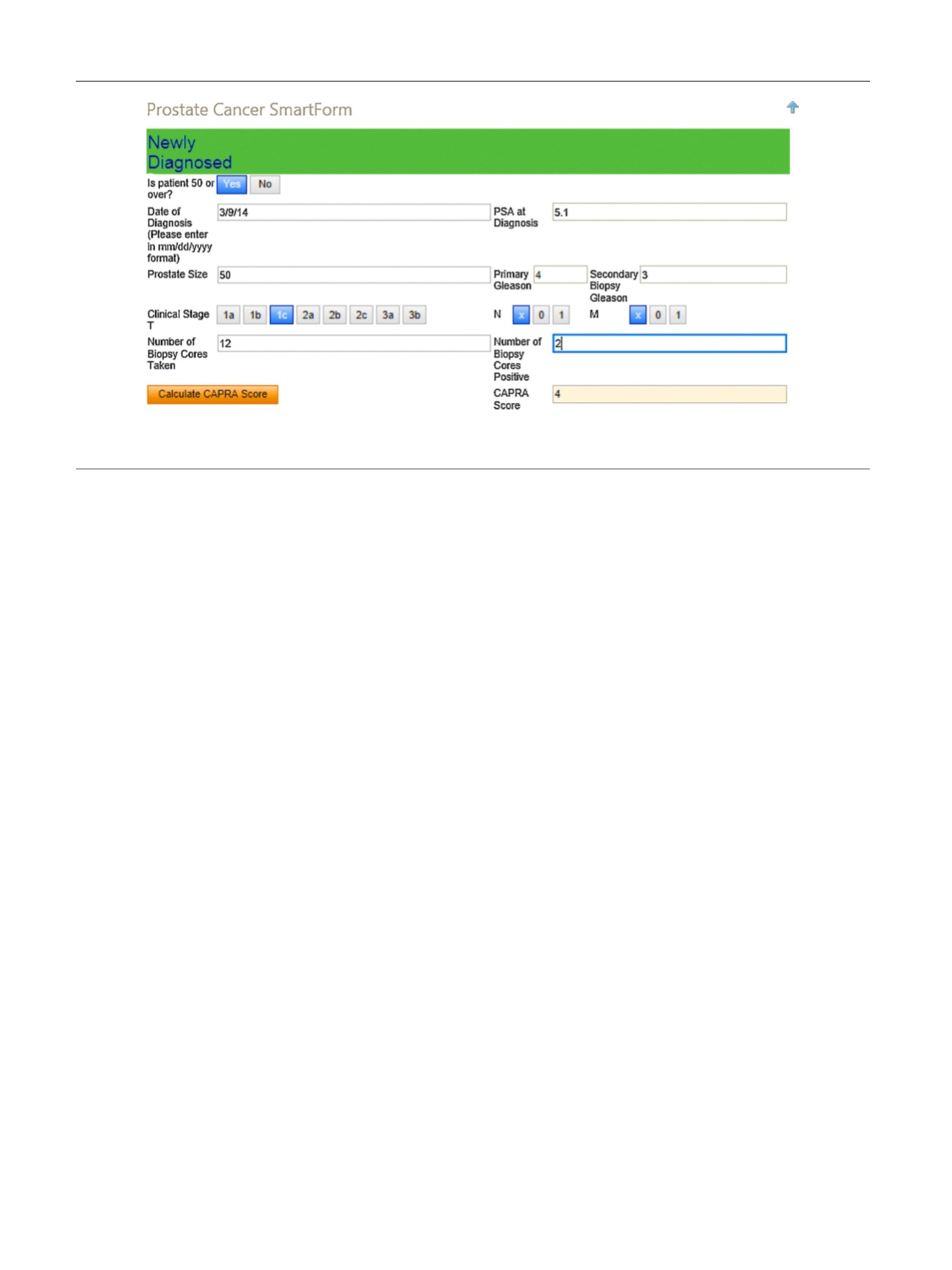

complex due to the dynamics of the disease and an
expanding array of tools that seek to offer prediction
beyond a standard set of clinical variables. Nonetheless, a
central role continues to exist for clinical risk prediction
models that serve as an important benchmark for gauging
the performance of novel tools. Therefore, although
advances in molecular and genetic characterization of
PCa have resulted in the development of assays and
biomarkers that offer further personalization of risk
prediction and stratification, it is crucial that the
magnitude of their putative benefit be examined against
a gold standard. It is in this domain that tools such as the
CAPRA and CAPRA-S scores have demonstrated clear
utility in serving as a validated standard for performance
for a number of emerging markers
[18,27,28]. A CAPRA
score calculator has also now been implemented directly
in the
[2_TD$DIFF]
Epic electronic health record system
( Fig. 4 ).
In an era of medicine increasingly driven toward
precision, it is clear that standardized risk assessment
must move beyond the older and insufficiently granular
approach of risk grouping to true multivariable risk
stratification. Now in a decade since its introduction, the
CAPRA score and its analogous derivatives, the CAPRA-S and
J-CAPRA scores, represent well-validated solutions to this
need by offering easy-to-use, clinically accurate, and
validated risk prediction models that hopefully will
continue to inform both clinical practice and research
studies.
Author contributions:
Matthew R. Cooperberg had full access to all the
data in the study and takes responsibility for the integrity of the data and
the accuracy of the data analysis.
Study concept and design:
Cooperberg.
Acquisition of data:
Cooperberg, Leapman, Brajtbord.
Analysis and interpretation of data:
Cooperberg, Brajtbord.
Drafting of the manuscript:
Brajtbord.
Critical revision of the manuscript for important intellectual content:
Leapman, Cooperberg.
Statistical analysis:
None.
Obtaining funding:
None.
Administrative, technical, or material support:
None.
Supervision:
Cooperberg.
Other (specify):
None.
Financial disclosures:
Matthew R. Cooperberg certifies that all conflicts
of interest, including specific financial interests and relationships and
affiliations relevant to the subject matter or materials discussed in the
manuscript (eg, employment/ affiliation, grants or funding, consultan-
cies, honoraria, stock ownership or options, expert testimony, royalties,
or patents filed, received, or pending), are the following: None.
Funding/Support and role of the sponsor:
None.
References
[1]
Cooperberg MR, Pasta DJ, Elkin EP, et al. The University of California, San Francisco Cancer of the Prostate Risk Assessment score: a straightforward and reliable preoperative predictor of disease recurrence after radical prostatectomy. J Urol 2005;173:1938–42.[2]
Shariat SF, Karakiewicz PI, Margulis V, Kattan MW. Inventory of prostate cancer predictive tools. Curr Opin Urol 2008;18:279–96.[3]
Cooperberg MR, Freedland SJ, Pasta DJ, et al. Multiinstitutional validation of the UCSF cancer of the prostate risk assessment for prediction of recurrence after radical prostatectomy. Cancer 2006; 107:2384–91.[4]
May M, Knoll N, Siegsmund M, et al. Validity of the CAPRA score to predict biochemical recurrence-free survival after radical prosta- tectomy. Results from a European multicenter survey of 1,296 patients. J Urol 2007;178:1957–62, discussion 1962.[5]
Zhao KH, Hernandez DJ, Han M, Humphreys EB, Mangold LA, Partin AW. External validation of University of California, San Francisco Cancer of the Prostate Risk Assessment score. Urology 2008;72: 396–400.[6]
Lughezzani G, Buda¨us L, Isbarn H, et al. Head-to-head comparison of the three most commonly used preoperative models for prediction[(Fig._4)TD$FIG]
Fig. 4 – Implementation of a Cancer of the Prostate Risk Assessment (CAPRA) calculator within an
[2_TD$DIFF]
Epic SmartForm.
CAPRA = Cancer of the Prostate Risk Assessment; PSA = prostate-specific antigen.
E U R O P E A N U R O L O G Y 7 1 ( 2 0 1 7 ) 7 0 5 – 7 0 9
708
















